Bikepacking and Personal Growth: Building Strength One Ride at a Time

Embracing Strength through Bikepacking
This is a guest blog by Mind & Mountain friend Oliviah Franke. Oliviah (they/she) is a biracial Cáhita person who is living on Dena'ina lands and works in Community Education for Native Movement. They are a cyclist, cat mom, gardener, and are very passionate about racial equity and community building.
Read on for more of their story: Strength is a concept that is not entirely foreign to me, but physical strength specifically is something I never assumed to have. I have known that I have emotional fortitude; a stubbornness to persevere and thrive despite all odds. As a child in the foster care system for the first 6 years of my life, my mental and emotional strength was tested and strengthened time and time again, and even as I grew older and found security and love through adoption; life still demanded a certain strength of me. But it definitely wasn’t physical strength that I focused on building. Because of this, I have never thought of myself as an athlete. Growing up, I never skied, snowboarded, kayaked, backpacked, or cycled long distances. I did spend a ton of time outside and connecting with nature, developing a strong relationship with plant relatives and quiet spaces near moving water. It was in those natural spaces that I was able to soften into my emotional safety; I was able to calm some of the storming inside my heart and mind.
Strength is a concept that is not entirely foreign to me, but physical strength specifically is something I never assumed to have. I have known that I have emotional fortitude; a stubbornness to persevere and thrive despite all odds. As a child in the foster care system for the first 6 years of my life, my mental and emotional strength was tested and strengthened time and time again, and even as I grew older and found security and love through adoption; life still demanded a certain strength of me. But it definitely wasn’t physical strength that I focused on building. Because of this, I have never thought of myself as an athlete. Growing up, I never skied, snowboarded, kayaked, backpacked, or cycled long distances. I did spend a ton of time outside and connecting with nature, developing a strong relationship with plant relatives and quiet spaces near moving water. It was in those natural spaces that I was able to soften into my emotional safety; I was able to calm some of the storming inside my heart and mind.
My journey into adventure cycling, and inevitably my athlete-hood, came after a several year hiatus. I grew up cycling in Portland Oregon for transportation but I never knew my bike well and I certainly was not centering joy in my cycling. So in 2021 when I got my first bike in Alaska after 5 years without riding, I was determined to be sure that my time on my bike was intentional and from a place of joy. I hadn’t named this yet, but I was integrating my relationship with biking into that softening of emotional strength. I have since realized that in allowing myself spaces to commune with my body and focus on developing physical strength, I was allowing myself more time and space with the vulnerability and kindness towards self that I had always compartmentalized.

 My first bikepacking trip was an overnighter to the back end of Eklutna Lake outside of Anchorage in late September. It was a 9 mile bike ride each direction and it unexpectedly had turned out to be an intro to winter bikepacking trip! I was overwhelmed and intimidated; socially withdrawn as I took in all of the learnings. How to pace myself on a weighted, packed bike was different, the amount of thought into my food and water was different. I learned about how to layer effectively to stay warm while not encouraging MORE saddle soreness (the more layers I have down there, the hotter it gets with friction and for my body… the worse my saddle sores are). I also made some discoveries about which kinds of backcountry foods agree with my body and what it means to push through physical discomfort and pain on day two.
My first bikepacking trip was an overnighter to the back end of Eklutna Lake outside of Anchorage in late September. It was a 9 mile bike ride each direction and it unexpectedly had turned out to be an intro to winter bikepacking trip! I was overwhelmed and intimidated; socially withdrawn as I took in all of the learnings. How to pace myself on a weighted, packed bike was different, the amount of thought into my food and water was different. I learned about how to layer effectively to stay warm while not encouraging MORE saddle soreness (the more layers I have down there, the hotter it gets with friction and for my body… the worse my saddle sores are). I also made some discoveries about which kinds of backcountry foods agree with my body and what it means to push through physical discomfort and pain on day two.
Despite the discomfort in the moment, I hadn’t yet realized the long term impacts I was having on my relationship to my body. It was one of the many drops in my self love bucket, that slowly filled drop by drop with each pedal stroke. My next bikepacking trip was an early spring fatbike ride out to a public use cabin on Lynx Lake. It felt VERY luxurious since the ride was so short and we were able to bring some items that made for quite a comfortable experience at the cabin. The rides to and from the cabin that weekend were very enjoyable and my goals were rooted more in just gaining experience riding on frozen bodies of water and layering in the cold. It has taken countless winter fat bike rides to dial in a wardrobe that makes me feel like I have enough mobility and allows me to be warm enough while also not overheating and causing me to sweat through layers.
My next bikepacking trip was an early spring fatbike ride out to a public use cabin on Lynx Lake. It felt VERY luxurious since the ride was so short and we were able to bring some items that made for quite a comfortable experience at the cabin. The rides to and from the cabin that weekend were very enjoyable and my goals were rooted more in just gaining experience riding on frozen bodies of water and layering in the cold. It has taken countless winter fat bike rides to dial in a wardrobe that makes me feel like I have enough mobility and allows me to be warm enough while also not overheating and causing me to sweat through layers.

Oliviah’s tips and tricks for winter biking clothing:
My best recommendation thus far, especially for those of us cyclists in larger bodies, is Duluth Trading Workwear. I usually use the Plus flexpedition fleece lined pants (up to a size 30!) paired with a synthetic base layer legging. I do recommend getting comfortable going commando in this setup, because as I mentioned, the more layers the more likely heat and friction will catch up to you and cause saddle sores. I tend to bike with my Xtratuff rainboots with thick socks or my Sorel Elk skin snow boots. They have lasted for many years and keep my feet very warm! I do use a longer pedal on my bikes, year round, but very importantly in the winter to provide more stability for a larger shoe. It was several months before I embarked on my third trip; an overnight trip 23 miles into Denali National Park. This trip was a big one; it was my first ride on my brand new gravel expedition bike build, a bike that had been donated to me by Stephen Wood of Swood. Chingona (my bike) was a sponsored build for me as I trained as a Ride for Racial Justice athlete in 2022. Ride for Racial Justice sends a team of BIPOC (Black, Indigenous, and People of Color) athletes to race in Steamboat Colorado every year. Each year, the RFRJ team takes up space in a dominantly white space and develops profound community and camaraderie with one another.
It was several months before I embarked on my third trip; an overnight trip 23 miles into Denali National Park. This trip was a big one; it was my first ride on my brand new gravel expedition bike build, a bike that had been donated to me by Stephen Wood of Swood. Chingona (my bike) was a sponsored build for me as I trained as a Ride for Racial Justice athlete in 2022. Ride for Racial Justice sends a team of BIPOC (Black, Indigenous, and People of Color) athletes to race in Steamboat Colorado every year. Each year, the RFRJ team takes up space in a dominantly white space and develops profound community and camaraderie with one another. Two weeks before the race, I finally received the new bike and promptly packed my bags, loaded the bike into my truck and headed to Denali National Park for my last big training ride. The ride into Denali National Park starts on a 15 mile section of paved road that is open to the public, before transitioning to a gravel road that only hosts tour buses. I ended up being spoiled with a car ride to the top of the first paved climb, so that I could focus my energy and strength on the major climb as soon as the gravel road started. I pushed myself up the first 1000 ft climb on my brand new bike and I was filled with so many emotions and realizations. I was stronger than I had been a few months prior. I had a tool, an incredible bike, that was made for me and made specifically for the task at hand. My body and this tool were working together to maximize energy and effort and I was feeling my confidence increase as I climbed higher and higher up the mountain.
Two weeks before the race, I finally received the new bike and promptly packed my bags, loaded the bike into my truck and headed to Denali National Park for my last big training ride. The ride into Denali National Park starts on a 15 mile section of paved road that is open to the public, before transitioning to a gravel road that only hosts tour buses. I ended up being spoiled with a car ride to the top of the first paved climb, so that I could focus my energy and strength on the major climb as soon as the gravel road started. I pushed myself up the first 1000 ft climb on my brand new bike and I was filled with so many emotions and realizations. I was stronger than I had been a few months prior. I had a tool, an incredible bike, that was made for me and made specifically for the task at hand. My body and this tool were working together to maximize energy and effort and I was feeling my confidence increase as I climbed higher and higher up the mountain.
Oliviah’s tips and tricks for climbing:
Climbing has always been my weakness and I am still not great at it. It certainly helps to have an incredible tool that has specific features and bike components that encourage a smooth, power efficient experience. However, I have always believed that all bikes are good bikes. If you are motivated to climb a lot on your rides, bikepacking or otherwise, I would absolutely encourage you to invest in a good drivetrain. Get comfortable shifting into your granniest (lowest or easiest) gear and moving slowly up the inclines. I also tend to, when safe to do so, weave my way across the road or trail, making my own mini switchbacks. You will ultimately be biking more mileage but the incline will feel easier and at the very least it gives me something to mentally focus on.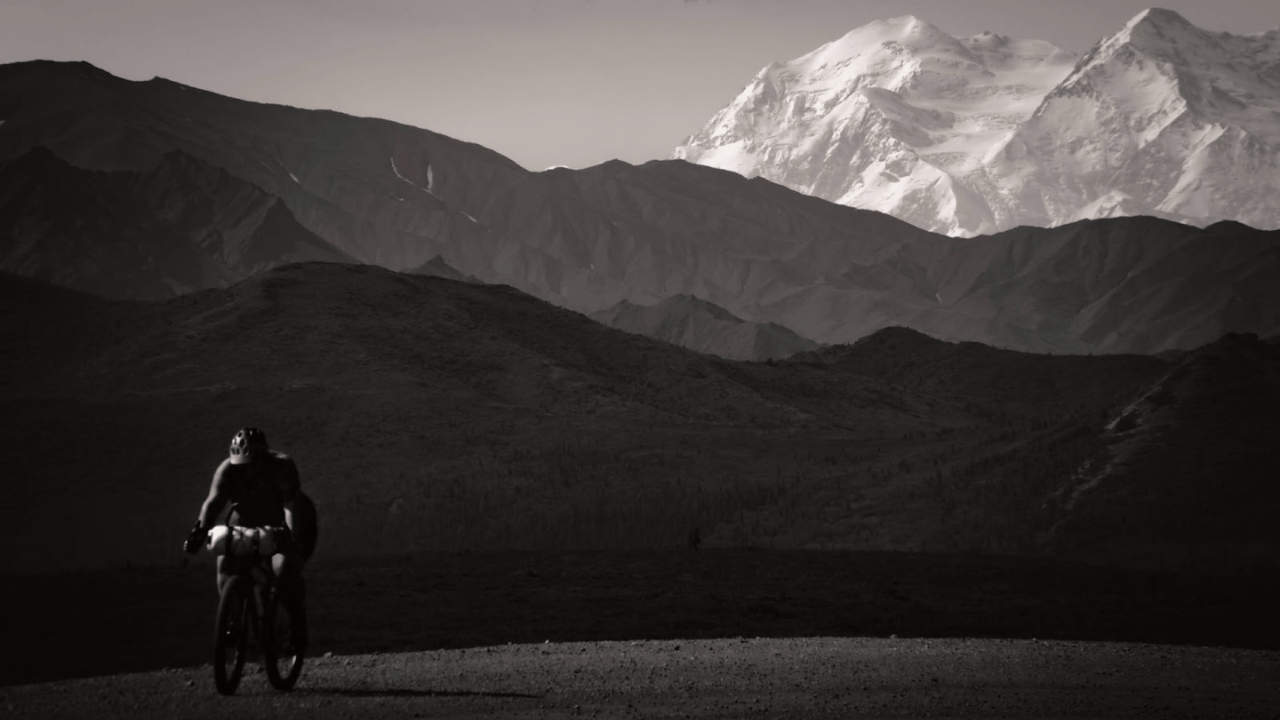 On that bikepacking adventure I began to realize perhaps, just maybe, I was a little physically stronger than I had thought all these years. Maybe, I did truly belong exactly where I was, doing exactly what I was doing, and I could feel peace in that. I didn’t have to fight so hard to be in that space, to be in the bikepacking and broadly, the cycling community.
On that bikepacking adventure I began to realize perhaps, just maybe, I was a little physically stronger than I had thought all these years. Maybe, I did truly belong exactly where I was, doing exactly what I was doing, and I could feel peace in that. I didn’t have to fight so hard to be in that space, to be in the bikepacking and broadly, the cycling community. It was through the experience of training for Ride for Racial Justice, as well as receiving the sponsored bike from Swood and many other industry partners, that the idea of bikepacking with the person who built my bike frame came to life. So, in October 2022, despite never meeting Stephen Wood, my partner at the time and I met up with him in New Bern North Carolina. It was somewhat surreal to have my brand new bike in a new state, reunited with the person who built the frame with his hands (WITH HIS HANDS! In his garage! From scratch! What a crazy skill to have)! It was even more surreal to realize that I was there to embark on only my fourth ever bikepacking trip and it was going to involve not only my longest bikepacking trip (3 days), but the first day was also going to be my longest day on a bike, ever. More importantly however, was the realization that what I was doing was perhaps the most uniquely intimate thing I could do with a stranger.
It was through the experience of training for Ride for Racial Justice, as well as receiving the sponsored bike from Swood and many other industry partners, that the idea of bikepacking with the person who built my bike frame came to life. So, in October 2022, despite never meeting Stephen Wood, my partner at the time and I met up with him in New Bern North Carolina. It was somewhat surreal to have my brand new bike in a new state, reunited with the person who built the frame with his hands (WITH HIS HANDS! In his garage! From scratch! What a crazy skill to have)! It was even more surreal to realize that I was there to embark on only my fourth ever bikepacking trip and it was going to involve not only my longest bikepacking trip (3 days), but the first day was also going to be my longest day on a bike, ever. More importantly however, was the realization that what I was doing was perhaps the most uniquely intimate thing I could do with a stranger. A few months prior, I had spent so much time worried about how my body would look and feel in a racing kit for Ride for Racial Justice. I had told folks that the scariest part of the experience was actually going to be putting the kit on… I could not fathom exposing my softness, my rolls, and my wrinkles and bigness to all of the athletes at the race. And yet, on race day I spent most of the day in my sports bra and bibs, allowing the other racers to see my back rolls and tummy line. I was comfortable and I was strong. I thought that was the bravest thing I would ever do on my bike and then came our time in North Carolina.
A few months prior, I had spent so much time worried about how my body would look and feel in a racing kit for Ride for Racial Justice. I had told folks that the scariest part of the experience was actually going to be putting the kit on… I could not fathom exposing my softness, my rolls, and my wrinkles and bigness to all of the athletes at the race. And yet, on race day I spent most of the day in my sports bra and bibs, allowing the other racers to see my back rolls and tummy line. I was comfortable and I was strong. I thought that was the bravest thing I would ever do on my bike and then came our time in North Carolina.
 Mary Oliver wrote: “If you have ever gone to the woods with me, I must love you very much” and that has always felt so true to me. Part of what makes my time near trees and water so important to me is because it is sacred. My relationship to land and place, my reliance on and reciprocity with plant relatives and the peace that I feel when I close my eyes and feel the wind on my cheek or smell the rain drops on the soil is my way of connecting with my spirit, it is what I hold sacred and has always been something I experience best in private. It has usually been something that I keep to myself, whispering my gratitudes and offerings under my breath and when separated from others. So to share three days uninterrupted with a stranger, in the woods, where I would be experiencing a layer of spirituality, was scary. It was going to be the bravest thing I had done on my bike and even if the place, circumstances, and people change over time, it continues to be the bravest intimacy I choose to share.
Mary Oliver wrote: “If you have ever gone to the woods with me, I must love you very much” and that has always felt so true to me. Part of what makes my time near trees and water so important to me is because it is sacred. My relationship to land and place, my reliance on and reciprocity with plant relatives and the peace that I feel when I close my eyes and feel the wind on my cheek or smell the rain drops on the soil is my way of connecting with my spirit, it is what I hold sacred and has always been something I experience best in private. It has usually been something that I keep to myself, whispering my gratitudes and offerings under my breath and when separated from others. So to share three days uninterrupted with a stranger, in the woods, where I would be experiencing a layer of spirituality, was scary. It was going to be the bravest thing I had done on my bike and even if the place, circumstances, and people change over time, it continues to be the bravest intimacy I choose to share. During our time in the Croatan, I biked 42 miles in one day and crashed on some soft gravel that resulted in a fractured toe. The next day, already stinging with saddle sores and wrapping my throbbing purple foot in some KT tape, I loosened my chaco straps as much as I could, to fit my foot in the only pair of shoes I had so that we could push on. The first hour or so of day two was filled with micro adjustments of my body so that I could attempt to find any comfort; finally realizing that the only solution was to settle in and breathe into the parts of my body that needed love. In the afternoon of the second day, there were about 5 miles of hike-a-bike through thick brush and around marshy puddles in the trail. I was pleasantly surprised that this was a welcome relief, I could walk (hobble/limp) using my bike as a support instead of sitting on my saddle. It was the break I needed to find my second wind so that once we could ride our bikes again I cruised to our second camp.
During our time in the Croatan, I biked 42 miles in one day and crashed on some soft gravel that resulted in a fractured toe. The next day, already stinging with saddle sores and wrapping my throbbing purple foot in some KT tape, I loosened my chaco straps as much as I could, to fit my foot in the only pair of shoes I had so that we could push on. The first hour or so of day two was filled with micro adjustments of my body so that I could attempt to find any comfort; finally realizing that the only solution was to settle in and breathe into the parts of my body that needed love. In the afternoon of the second day, there were about 5 miles of hike-a-bike through thick brush and around marshy puddles in the trail. I was pleasantly surprised that this was a welcome relief, I could walk (hobble/limp) using my bike as a support instead of sitting on my saddle. It was the break I needed to find my second wind so that once we could ride our bikes again I cruised to our second camp.
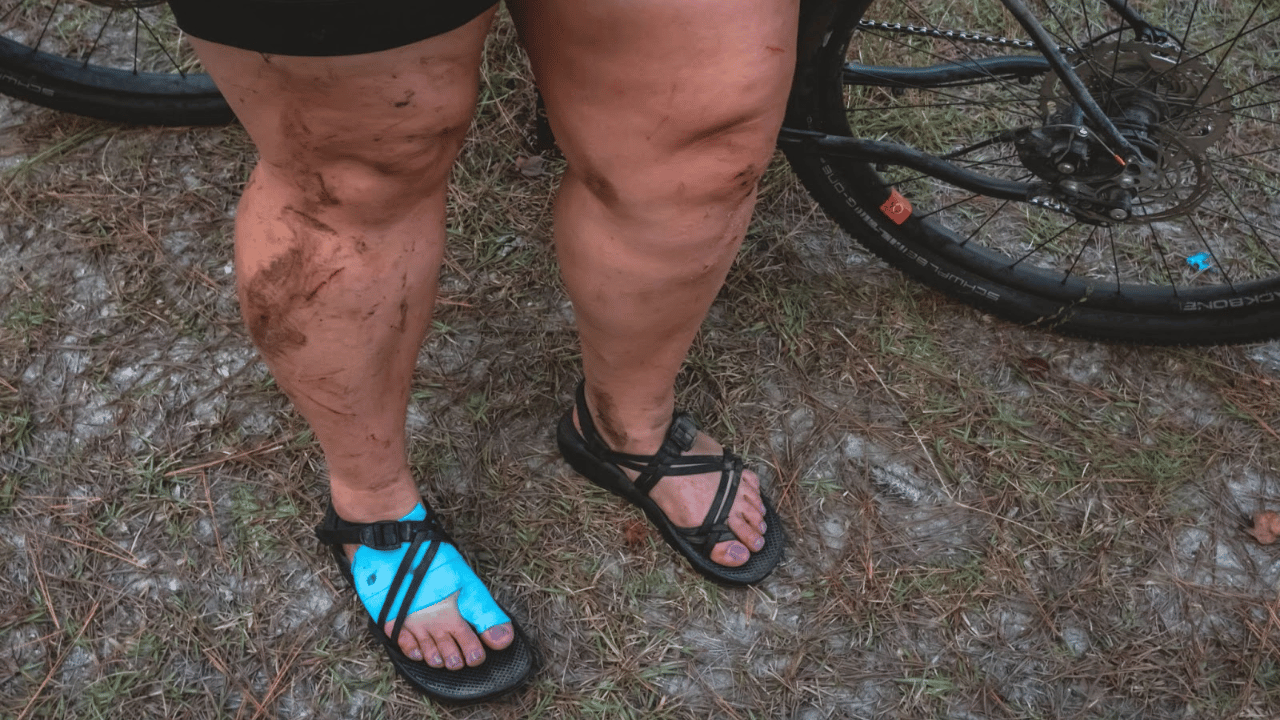

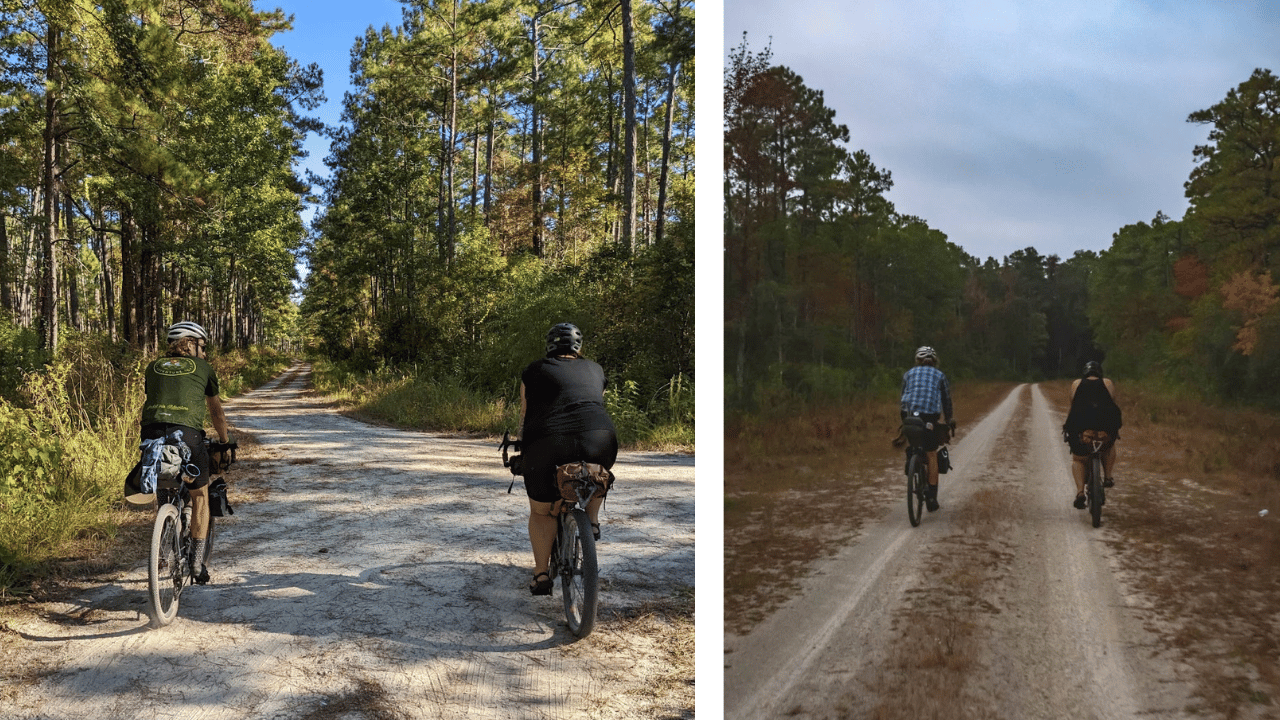 Day three was the point where I realized my body would not be able to finish the final 20 miles. I tapped out and sat at a Dairy Queen while my two companions finished the route to the car and circled back to me. I was proud of myself, I felt at peace with my decision to stop where I did. I had accomplished so much more than I thought I was capable of. From both a perspective of mileage and stats as well as the perspective of personal accomplishment, I had more than accomplished what I had set out to do.
Day three was the point where I realized my body would not be able to finish the final 20 miles. I tapped out and sat at a Dairy Queen while my two companions finished the route to the car and circled back to me. I was proud of myself, I felt at peace with my decision to stop where I did. I had accomplished so much more than I thought I was capable of. From both a perspective of mileage and stats as well as the perspective of personal accomplishment, I had more than accomplished what I had set out to do.
Oliviah’s tips and tricks… body and mind:
Always carry as holistic a first aid kit as you can muster. Even if you are biking on flat roads and trails, closed toed shoes and ones with ankle support are helpful in case of crashes or changes in trail conditions. Your strength is determined not by your body size or muscle mass. It is determined by the collective of your mental fortitude and plasticity as well as your physical conditioning and the strength of the people you surround yourself with on your adventures. Mental plasticity will allow for creative solutions, adjustments to expectations and plans, and more importantly the ability to change your mindset when needed. Routes may change from when you do your research to getting to the field and adjustments are almost always needed once you are on the ground. Injuries, body discomfort, stomach pain and indigestion, etc. are all things that will push against your mentality so having a toolkit for adjusting mindset and camping nervous system responses are incredibly important. Second, physical conditioning. To me, it is less about how strong you are physically. It is less about your muscles and body size or shape and more about your comfort with physical discomfort and pain. Is your body conditioned to sitting on a saddle with sores and pushing your pedals through a foot cramp? How can you slowly expose your body to these sensations in bite sized chunks and build up your conditioning over time? Lastly, the people that you chose to adventure with will make or break an experience. They can hold you up when you are low, they can comfort you or give you space when you are crying in the middle of the woods on a backroad in a state you have never been to. If the company you are with are not supportive, empathetic, encouraging, silly, and creative the experience may very well be much less enjoyable. It’s now been ten months since that bikepacking trip and every time I spend time reflecting on the experience I am overwhelmed by new threads of thoughts and feelings. An experience like that cannot be summarized in one sitting and I continue to be in awe of the life of a story. As time passes the story itself evolves, changes, grows, and matures; it has a life of its own. Bikepacking is a beautiful puzzle game of logistics planning, gear and food menus, a selection of place characteristics and knowledge, a test of mental and physical fortitude, an invitation for emotional exploration and expansion, and most important it is a journey with self, community, and land.
It’s now been ten months since that bikepacking trip and every time I spend time reflecting on the experience I am overwhelmed by new threads of thoughts and feelings. An experience like that cannot be summarized in one sitting and I continue to be in awe of the life of a story. As time passes the story itself evolves, changes, grows, and matures; it has a life of its own. Bikepacking is a beautiful puzzle game of logistics planning, gear and food menus, a selection of place characteristics and knowledge, a test of mental and physical fortitude, an invitation for emotional exploration and expansion, and most important it is a journey with self, community, and land. My time in the Croatan National Forest with Stephen Wood and Cameron Sanders continues through time to be shaped by themes of intimacy and strength and the interwoven complex ways those two things are symbiotic. Even in my few short bikepacking trips; I have learned that we are stronger than we think. Our bodies can do incredible things and we can accomplish so much when we lovingly care for them. Our communities and relationships can accomplish so much when we allow intimacy in, when we allow ourselves to open up to the experience of sharing what we might easily keep private. We have so much to learn from ourselves, our loved ones (and strangers who become loved ones), and from the land we explore and live on.
My time in the Croatan National Forest with Stephen Wood and Cameron Sanders continues through time to be shaped by themes of intimacy and strength and the interwoven complex ways those two things are symbiotic. Even in my few short bikepacking trips; I have learned that we are stronger than we think. Our bodies can do incredible things and we can accomplish so much when we lovingly care for them. Our communities and relationships can accomplish so much when we allow intimacy in, when we allow ourselves to open up to the experience of sharing what we might easily keep private. We have so much to learn from ourselves, our loved ones (and strangers who become loved ones), and from the land we explore and live on.
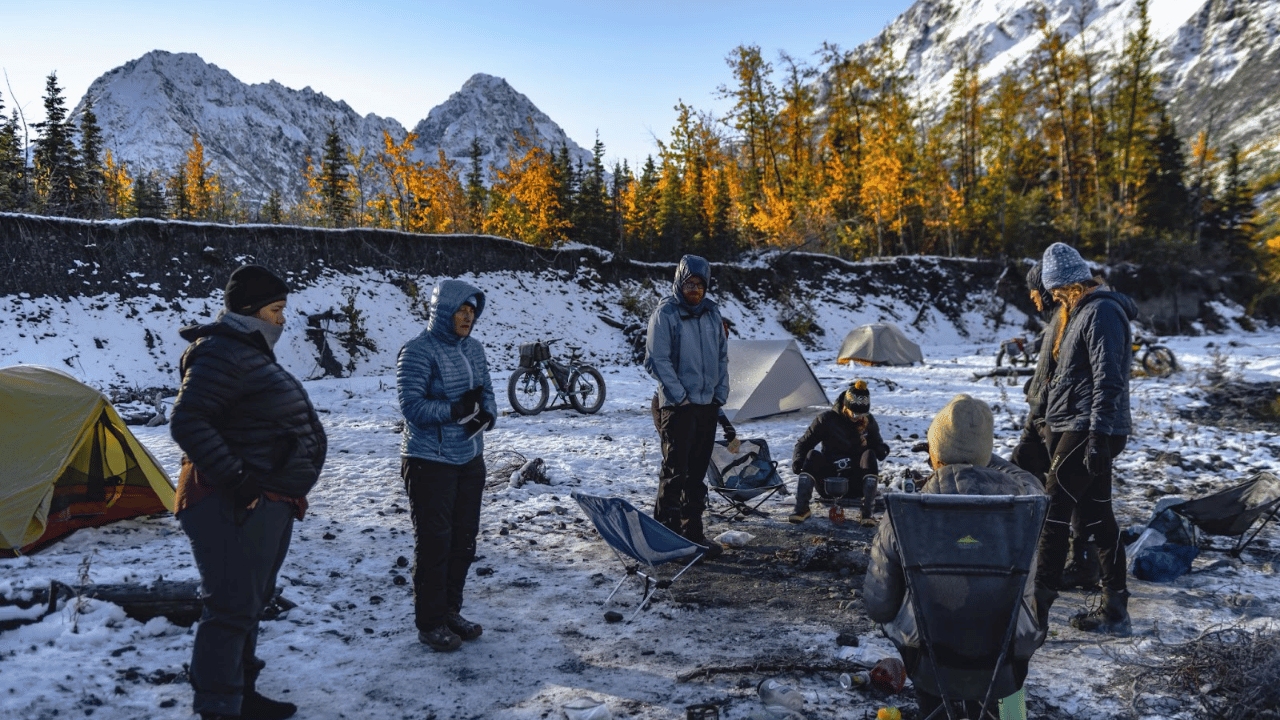
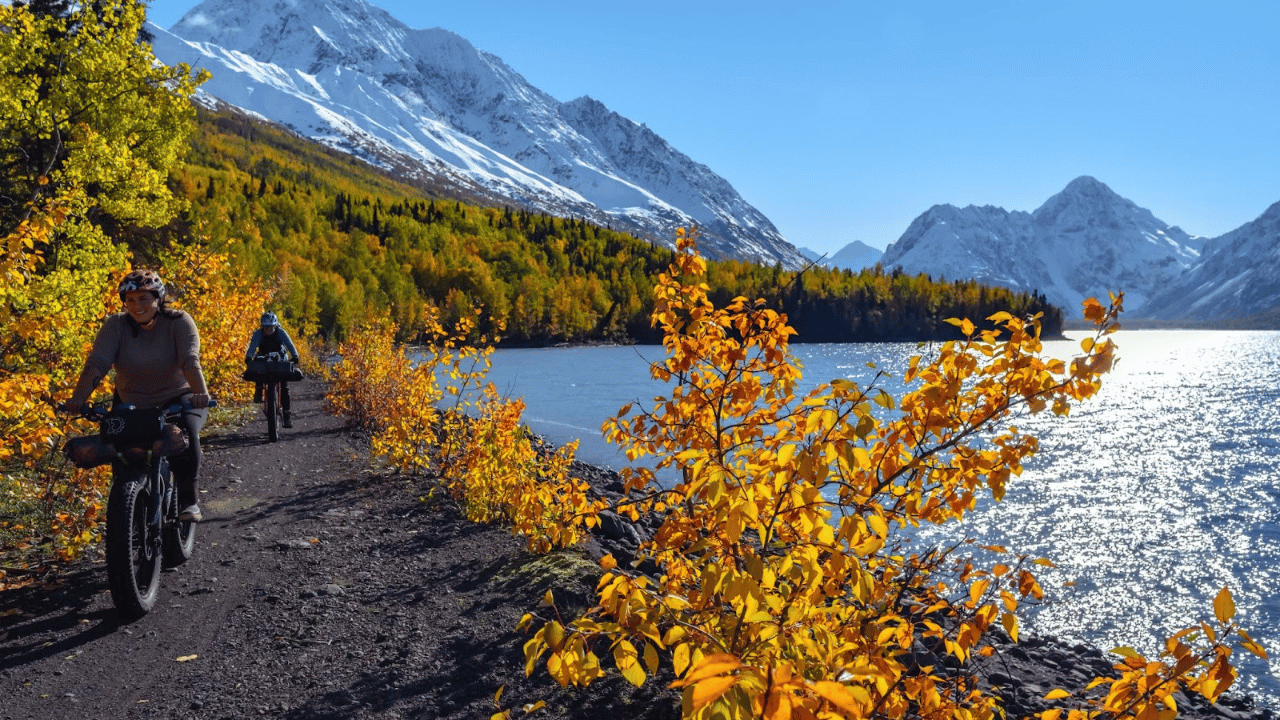 All photos taken by Cameron Sanders, Renaissance Cyclist
All photos taken by Cameron Sanders, Renaissance Cyclist
About the Author:
Oliviah (they/she) is a biracial Cáhita person who is living on Dena'ina lands and works in Community Education for Native Movement. They also are a co-founder of BSpoke (IG: @b.spoke_ak), a group that works to uplift BIPOC cyclists in Alaska through community organizing and the development of deep meaningful relationships. They are a cyclist, cat mom, gardener, and are very passionate about racial equity and community building. Follow along with Oliviah's journey on Instagram @oliviahfranke.
